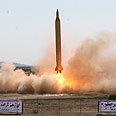
The United States will test its core missile defenses for the first time in January against a simulated long-range Iranian attack, a top Pentagon official said on Monday, amid tensions with Tehran.
Speaking at the Reuters Aerospace and Defense Summit in Washington, Army Lieutenant General Patrick O'Reilly, the head of the Missile Defense Agency, said the roughly $150 million test was a departure from the more standard scenario of a North Korean attack.
It also would be more difficult testing the US Ground-based Midcourse Defense (GMD) system against a missile that would be faster and more direct as it races toward the United States than a simulated strike from North Korea.
"Previously, we have been testing the GMD system against a North Korean-type scenario," O'Reilly said.
"This next test ... is more of a head-on shot like you would use defending against an Iranian shot into the United States. So that's the first time that we're now testing in a different scenario."
His comments came the same day that diplomats disclosed concerns among intelligence agencies that Iran tested a key atomic bomb component as recently as 2007. The finding, if proven true, would clash with Iran's assertion that its nuclear work is for civilian use.
The test would fire an interceptor missile from Vandenberg Air Force Base in California at a simulated incoming missile, launched from the Marshall Islands in the Pacific Ocean. An aide to O'Reilly estimated the cost at about $150 million.
Experts compare the simulation to a bullet hitting another bullet in space. O'Reilly said the goal was to destroy the target over the north central Pacific when the missiles had a combined closing speed of more than 17,000 miles per hour (27,000 kph).
"Whenever we have a situation where we're taking on a missile more head on than from the side, that increases the challenges," O'Reilly said.
Russia, Japan
US President Barack Obama revamped the US missile defense strategy for Europe in September to focus more on Iranian short- and medium-range missiles.
"The development of that (Iranian) long-range threat has been slower than what was originally estimated, and the pace of the medium-range missiles is dramatically higher," he said.
Obama's revamp may clear the way for collaboration with Russia, which had fiercely opposed a Bush-era plan to put ground-based interceptors in Poland and a related radar system in the Czech Republic.
O'Reilly said Washington and Moscow were in regular contact to exchange ideas on possible collaboration.
"We've proposed a large number of ideas, starting with sharing data from their sensors and our sensors, moving all the way to cooperative development, cooperative testing and so forth," he said.
"So they have expressed an interest, and shown it through subsequent technical working group meetings."
Turning to Japan, O'Reilly said that the new Japanese government had reaffirmed its commitment, in talks with him last month in Tokyo, to develop the next generation of SM-3 interceptors.
Boeing Co is the prime contractor for the GMD and Raytheon is the prime contractor for the SM-3.
"I just recently returned from a joint review with the Japanese. We are committed to that program and they have expressed that they remained committed," he said.
He said the new SM-3 missile would be about twice the weight and twice the range of the previous generation.
"And there are obviously opportunities for follow-on. But right now we agreed we are focused on the development to ensure that is successful first," he said.















